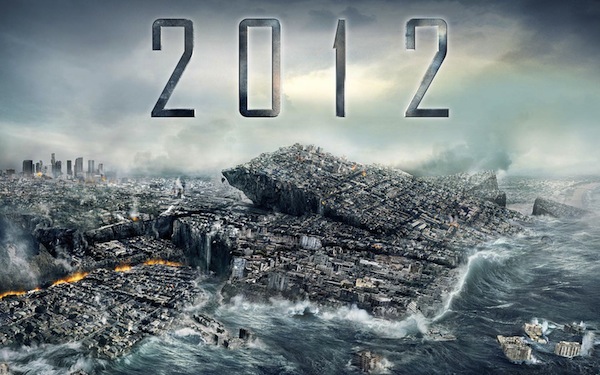![]() As earth scientists and science bloggers, Anne and I can’t help but feel a little trepidation as we enter 2012. The 21st of December this year marks the end of the 13th bak’tun of the Maya Long Count calendar. In the physical world, this date has about as much significance as the turn of the millennium does (or did) in the Gregorian calendar most countries currently use: in other words, none whatsoever. But it is also a date that has long been seized upon by apocalypse-mongers of all stripes as a prime candidate for the day that our world will be swallowed up in fire and chaos. Sadly for us earth scientists, many of the ‘theories’ as to how our doom will unfold involve geology: The poles will flip! The earth will tilt on its axis! The poles will flip and the earth will tip on its axis! Lands sinking into the sea! Earthquakes! (Super)volcanoes! Rains of curry!
As earth scientists and science bloggers, Anne and I can’t help but feel a little trepidation as we enter 2012. The 21st of December this year marks the end of the 13th bak’tun of the Maya Long Count calendar. In the physical world, this date has about as much significance as the turn of the millennium does (or did) in the Gregorian calendar most countries currently use: in other words, none whatsoever. But it is also a date that has long been seized upon by apocalypse-mongers of all stripes as a prime candidate for the day that our world will be swallowed up in fire and chaos. Sadly for us earth scientists, many of the ‘theories’ as to how our doom will unfold involve geology: The poles will flip! The earth will tilt on its axis! The poles will flip and the earth will tip on its axis! Lands sinking into the sea! Earthquakes! (Super)volcanoes! Rains of curry!
The world will not end in 2012, but it is likely to be a high-water mark for earth science-related hysteria. Even more than usual, any natural disaster, anywhere, risks being pronounced as a dire omen of the greater catastrophe to come. As we gear ourselves up to fight this torrent of nonsense, one thing that is surely needed for the coming twelve months is a proper baseline. Given that natural disasters occur all the time, what sort of geological activity should we expect if it is just a normal year on Planet Earth? The following list of expectations comes with a side-order of snark and a warning: this list of ‘predictions’ is based on a historical record that is often shorter than we ideally need (particularly for earthquakes) and is covering systems that are naturally variable in their behaviour over time. Consider it a starting null hypothesis against which the significance of your theories of imminent doom should be tested.
In 2012:
- The Earth’s tectonic plates will continue to move across the mantle at a few centimetres a year. Earthquakes and volcanoes will result in the usual fashion.
- Based on the last century of seismic activity, there will be 10-20 earthquakes with a moment magnitude greater than 7.0, with a good chance that at least one will exceed magnitude 8. Most of the largest are likely to be associated with subduction zones, with the consequent risk of a tsunami if they rupture at shallow depths.
- There will be more than a hundred earthquakes between magnitude 6 and 7, which have the potential to cause considerable damage if the rupture occurs close to a major city.
- As Erik Klemetti will tell you, volcanic eruptions happen all the time, and in 2012 they will continue to do so. Some will fairly harmlessly ooze lava; others will behave more explosively, mimicing this year’s Pliny-winning Puyehue-Cordón Caulle in Chile. But unless something really spectacular happens, akin to Mount Pinatubo’s eruption in 1991, all of these eruptions will be eclipsed by breathless speculation about any slight seismic activity that occurs beneath Katla, the Yellowstone caldera, or any volcano in the Pacific Northwest.
- In a number of places, too much rain will fall in too short a time, and flooding will result. When this occurs in a rich western country, there will be relatively low casualties, a large bill for damages, and lots of media coverage; when it happens in a poorer country, casualties will be higher and many more people will be displaced, but the media will pay far less attention.
- The Earth’s magnetic poles will migrate a few tens of kilometres from their present position. This may lead to a few airports re-marking their runways, but is not a sign that the field is about to reverse. If you hear talk of the dipole field’s recent weakening and this being a sign of the field gearing up for a reversal – and in my opinion, it’s at least a few centuries to soon to tell – remember that the whole process takes 5,000 to 10,000 years. Come December 22, your compass will still point north.
- Scientists will continue point to the serious consequences of climate change as a result of anthropogenic greenhouse gas emissions (which will continue to inexorably rise). The climate itself will continue to push up past the ‘normal’ range in which our civilisation developed and is tuned to flourish in. The resulting extreme weather events – be they heatwaves, floods, or unusually powerful storms – are far more likely to be attributed to mystical cosmic cycles than our disruption of the carbon cycle.
Every year, some parts of the world are suddenly struck by natural disasters, taking lives and destroying property. 2012 will, unfortunately, be no different. But just as in every over year, there will be nothing more cataclysmic going on in the next twelve months than the Earth’s normal geological and meterological processes – although, in the latter case, the planet is getting an increasingly large helping hand from us.




Comments (6)